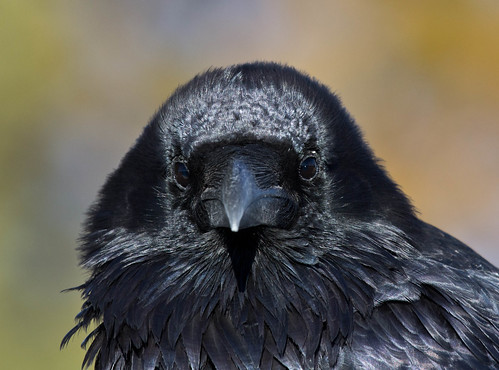For the Birds Radio Program: Crows and Ravens
What is the difference between crows and ravens?
Transcript

(Recording of an American Crow)
Now that winter is really here, many of Duluth’s crows are lighting out for the territory. Most of them don’t go too far–just down to tropical Minneapolis or thereabouts. In place of the crows, we get ravens. For the past couple of weeks, I’ve been watching large flocks of ravens passing over Hawk Ridge and the area around Cathedral High School–as they move into residential neighborhoods in town, they bully the smaller crows. In eight out of every ten years or so, ravens greatly outnumber crows by late December.
But even in the worst of winters, a few crows always remain. The fewest crows seen on a Duluth Christmas Birds Count in the last ten years was 4 crows counted in 1976, when 71 ravens were tallied. But in 1982 and 1984, crows actually outnumbered the ravens. In the bird world, rules are just averages, especially with species as adaptable as crows and ravens. The solid black coloration of both species helps them to absorb radiant energy, keeping them alive on the coldest days.
This year the Lakeside neighborhood winter ravens are back, lording over their turf along Superior Street. But there are still several members of a local street gang of crows sticking it out. They brazenly and gleefully harass any raven that dares cross some invisible line somewhere around Peabody Street.
When a raven is chased by one or two crows overhead, it’s easy to see and appreciate the size difference between the two species. But it’s a rare birder who can distinguish a single crow or raven by size alone. The easiest way to tell the two apart is by call. Crows caw:
(Recording of an American Crow)
Ravens croak–If you’ve ever watched “Hee Haw,” the bird in the cornfield sounds like a raven:
(Recording of a Common Raven)
Fortunately, crows and ravens are both pretty noisy, so you usually hear them call as they pass over. But if a silent one flies by, look at the tail. If the tail feathers are longer in the center than on the sides, producing a wedge-shaped appearance, the bird is a raven. If the tail feathers are all about the same length, so the tip of the tail looks evenly rounded, the bird is a crow.
Another good way of telling ravens from crows is that if the bird flies with its mouth hanging open, it’s probably a raven.
The loud, raucous calls of crows and ravens, combined with their somber black plumage, give these birds an aura of evil. Edgar Allen Poe’s raven, calling “Nevermore,” may have inspired Walt Disney’s artists to give the wicked Maleficent a pet raven in “Sleeping Beauty.” Oddly enough, though, Disney cartoonists, and the creators of “Heckle and Jeckle,” portray both crows and ravens with orange or yellow bills, even though no species of crow, raven, or jackdaw–American or Eurasian–has a bill color like that. It’s possible that California studio artists combined the body of a real crow with the beak of a Yellow-billed Magpie, a bird whose range is limited to the Sacramento Valley. I wrote a letter to the Disney Studios asking them to clarify this critical matter–when the mystery is cleared up, I’ll let you know.
(Recording of a raven)
This is Laura Erickson, and this program has been “For the Birds.”
